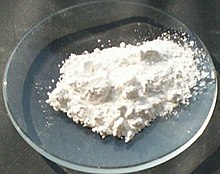Term: Calcium hydroxide
**Properties of Calcium Hydroxide:**
– Poor solubility in water
– Retrograde solubility with temperature
– Solubility product of 5.02×10
– Reacts with hydrogen chloride
– Soluble in glycerol and acids
– Polymeric structure
**Occurrence and Preparation of Calcium Hydroxide:**
– Produced by treating lime with water
– Can be prepared in the laboratory by mixing calcium chloride and sodium hydroxide
– Found in some volcanic, plutonic, and metamorphic rocks
– Detected in the atmosphere of S-type stars
**Retrograde Solubility of Calcium Hydroxide:**
– Known since the works of Berthelot and Thomsen
– Involves an entropy decrease
– Referred to as retrograde or inverse solubility
– Dissolution is exothermic
**Uses of Calcium Hydroxide:**
– Preparation of lime mortar
– Flocculant in water and sewage treatment
– Preparation of ammonia gas
– Intermediate in the production of sodium hydroxide in the paper industry
– Fungicide in orchard crops and dentistry
**Health Risks, Chemical Properties, and Additional Information:**
– Health risks: Can cause severe skin irritation, chemical burns, blindness, lung damage, or rashes
– Chemical properties: Dissociation constants, solubility in water, thermal dissociation behavior, thermodynamic functions in solution, stability in different chemical environments
– Historical studies and publications: Studies on hydrogen positions in portlandite, thermochemical investigations, solubility experiments, thermodynamic functions analysis
– Applications and regulations: Approval as a basic substance by the EU, technical evaluation for agricultural use, cooking applications with alkali, mushroom growing substrate preparation, intoxicating snuff rituals overview
– Educational resources and references: National Lime Association properties, technical advisory panel reviews, chemical hazards guide, chemical principles textbook reference
– External links for further information: Properties of commercial lime products, solubility data in water resource, MSDS for calcium hydroxide, National Organic Standards Board review, molecules in astrophysics publication
Calcium hydroxide (traditionally called slaked lime) is an inorganic compound with the chemical formula Ca(OH)2. It is a colorless crystal or white powder and is produced when quicklime (calcium oxide) is mixed with water. It has many names including hydrated lime, caustic lime, builders' lime, slaked lime, cal, and pickling lime. Calcium hydroxide is used in many applications, including food preparation, where it has been identified as E number E526. Limewater, also called milk of lime, is the common name for a saturated solution of calcium hydroxide.

| |

| |
| Names | |
|---|---|
| IUPAC name
Calcium hydroxide
| |
Other names
| |
| Identifiers | |
3D model (JSmol)
|
|
| ChEBI | |
| ChemSpider | |
| ECHA InfoCard | 100.013.762 |
| EC Number |
|
| E number | E526 (acidity regulators, ...) |
| 846915 | |
| KEGG | |
PubChem CID
|
|
| RTECS number |
|
| UNII | |
CompTox Dashboard (EPA)
|
|
| |
| |
| Properties | |
| Ca(OH)2 | |
| Molar mass | 74.093 g/mol |
| Appearance | White powder |
| Odor | Odorless |
| Density | 2.211 g/cm3, solid |
| Melting point | 580 °C (1,076 °F; 853 K) (loses water, decomposes) |
| |
Solubility product (Ksp)
|
5.02×10−6 |
| Solubility |
|
| Acidity (pKa) | pKa1 = 12.63 pKa2 = 11.57 |
| −22.0·10−6 cm3/mol | |
Refractive index (nD)
|
1.574 |
| Structure | |
| Hexagonal, hP3 | |
| P3m1 No. 164 | |
a = 0.35853 nm, c = 0.4895 nm
| |
| Thermochemistry | |
Std molar
entropy (S⦵298) |
83 J·mol−1·K−1 |
Std enthalpy of
formation (ΔfH⦵298) |
−987 kJ·mol−1 |
| Hazards | |
| GHS labelling: | |
 
| |
| Danger | |
| H314, H335, H402 | |
| P261, P280, P305+P351+P338 | |
| NFPA 704 (fire diamond) | |
| Flash point | Non-flammable |
| Lethal dose or concentration (LD, LC): | |
LD50 (median dose)
|
7340 mg/kg (oral, rat) 7300 mg/kg (mouse) |
| NIOSH (US health exposure limits): | |
PEL (Permissible)
|
TWA 15 mg/m3 (total) 5 mg/m3 (resp.) |
REL (Recommended)
|
TWA 5 mg/m3 |
IDLH (Immediate danger)
|
N.D. |
| Safety data sheet (SDS) | |
| Related compounds | |
Other cations
|
Magnesium hydroxide Strontium hydroxide Barium hydroxide |
Related bases
|
Calcium oxide |
| Supplementary data page | |
| Calcium hydroxide (data page) | |
Except where otherwise noted, data are given for materials in their standard state (at 25 °C [77 °F], 100 kPa).
| |

